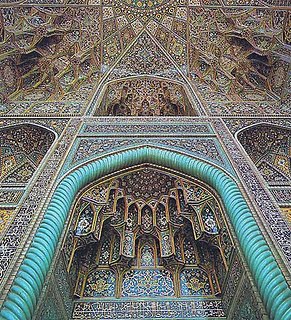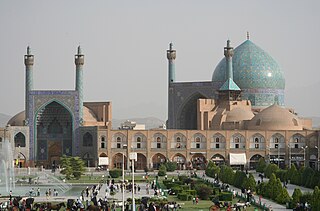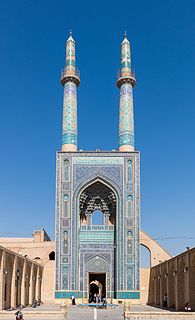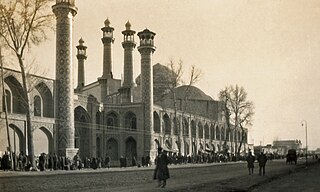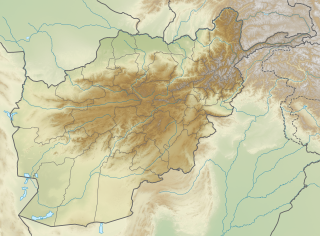| Emam school | |
|---|---|
| Religion | |
| Affiliation | Islam |
| Province | Isfahan |
| Location | |
| Location | Kashan, Iran |
| Municipality | Kashan |
| Geographic coordinates | 33°58′58″N51°26′51″E / 33.982817°N 51.447567°E Coordinates: 33°58′58″N51°26′51″E / 33.982817°N 51.447567°E |
| Architecture | |
| Type | Theological school |
| Style | Isfahani |
The Emam school is a historical school in Kashan, Iran. The school belongs to the Fath Ali Shah's era.

Kashan is a city in Isfahan province, Iran. At the 2017 census, its population was 396,987 in 90,828 families.

Iran, also called Persia, and officially the Islamic Republic of Iran, is a country in Western Asia. With over 81 million inhabitants, Iran is the world's 18th most populous country. Its territory spans 1,648,195 km2 (636,372 sq mi), making it the second largest country in the Middle East and the 17th largest in the world. Iran is bordered to the northwest by Armenia and the Republic of Azerbaijan, to the north by the Caspian Sea, to the northeast by Turkmenistan, to the east by Afghanistan and Pakistan, to the south by the Persian Gulf and the Gulf of Oman, and to the west by Turkey and Iraq. Its central location in Eurasia and Western Asia, and its proximity to the Strait of Hormuz, give it geostrategic importance. Tehran is the capital, largest city, and leading economic and cultural center.
The Emam school was built between 1806 and 1814 on the order of Hossein Khan Sadr-e Azam and under the supervision of Mirza Abolghassem Esfahani. The portal of the school has beautiful tiles. Its vast courtyard is rectangular and there are 52 chambers around it. On the northern and southern sides of the courtyard, there are two large halls for teaching and discussing of seminarians. Each hall has a separate corridor, which leads to backyard. Each backyard has three chambers with basement and high windcatchers. On the west side of the yard and opposite the portal, there is a vast splendid iwan. From the inscription on the ceiling of the iwan to its floor, it is decorated with Haft Rang tiles. The brick dome of the mosque is two-layered. The inside layer of the dome is 27 m high. [1]

A portal is an opening in a wall of a building, gate or fortification, especially a grand entrance to an important structure. Doors, metal gates, or portcullis in the opening can be used to control entry or exit. The surface surrounding the opening may be made of simple building materials or decorated with ornamentation. The elements of a portal can include the voussoir, tympanum, an ornamented mullion or trumeau between doors, and columns with carvings of saints in the westwork of a church.

A tile is a thin object usually square or rectangular in shape. Tile is a manufactured piece of hard-wearing material such as ceramic, stone, metal, baked clay, or even glass, generally used for covering roofs, floors, walls, or other objects such as tabletops. Alternatively, tile can sometimes refer to similar units made from lightweight materials such as perlite, wood, and mineral wool, typically used for wall and ceiling applications. In another sense, a tile is a construction tile or similar object, such as rectangular counters used in playing games. The word is derived from the French word tuile, which is, in turn, from the Latin word tegula, meaning a roof tile composed of fired clay.

A courtyard or court is a circumscribed area, often surrounded by a building or complex, that is open to the sky. Such spaces in inns and public buildings were often the primary meeting places for some purposes, leading to the other meanings of court. Both of the words court and yard derive from the same root, meaning an enclosed space. See yard and garden for the relation of this set of words.


